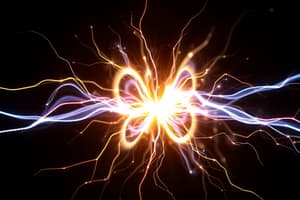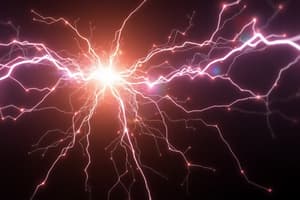Podcast
Questions and Answers
What is the primary function of the electoral college in the US?
What is the primary function of the electoral college in the US?
- To appoint Supreme Court judges
- To allocate funds for federal programs
- To pass amendments to the Constitution
- To elect the President and the Vice President (correct)
Which of the following is NOT a power of the President of the US?
Which of the following is NOT a power of the President of the US?
- Declaring war
- Conducting foreign policy
- Impeaching federal officials (correct)
- Appointing federal judges and ambassadors
What is the main purpose of the system of checks and balances in the US government?
What is the main purpose of the system of checks and balances in the US government?
- To prevent any one branch of government from becoming too powerful (correct)
- To ensure the President has absolute power
- To give Congress more power than the President
- To allow the judiciary to make laws
What is the term for the process of allocating seats in the House of Representatives to states based on their population?
What is the term for the process of allocating seats in the House of Representatives to states based on their population?
What is the minimum age requirement to be eligible to serve as a member of the US House of Representatives?
What is the minimum age requirement to be eligible to serve as a member of the US House of Representatives?
Study Notes
Electric Charges and Fields
- Electric charge is a fundamental property of matter, and it is measured in coulombs (C).
- There are two types of electric charges: positive and negative.
- Like charges repel each other, while opposite charges attract each other.
- Electric charge is quantized, meaning it comes in discrete packets (quanta) rather than being continuous.
- The smallest unit of electric charge is the elementary charge (e), which is approximately 1.6 × 10^-19 C.
Coulomb's Law
- Coulomb's Law states that the electric force between two point charges is proportional to the product of the magnitudes of the charges and inversely proportional to the square of the distance between them.
- The law is given by the equation: F = k * (q1 * q2) / r^2, where F is the electric force, k is Coulomb's constant, q1 and q2 are the magnitudes of the charges, and r is the distance between them.
- The value of Coulomb's constant (k) is approximately 9 × 10^9 N m^2 C^-2.
Electric Field
- An electric field is a region around a charged particle where the force of the charge can be detected.
- Electric field lines emerge from positive charges and enter negative charges.
- The electric field (E) at a point is defined as the force (F) per unit charge (q) at that point: E = F / q.
- Electric field is a vector quantity, and its unit is newton per coulomb (N/C) or volt per meter (V/m).
Electric Dipole
- An electric dipole consists of two point charges of equal magnitude but opposite signs, separated by a small distance.
- The electric dipole moment (p) is a measure of the strength of the dipole, given by p = q × d, where q is the magnitude of the charge and d is the distance between the charges.
- The electric field of a dipole decreases rapidly with distance, and its direction is along the line joining the charges.
Studying That Suits You
Use AI to generate personalized quizzes and flashcards to suit your learning preferences.
Description
Understand the fundamental property of matter, electric charge, its measurement, types, and behavior. Learn about Coulomb's Law and the quantization of electric charge.




